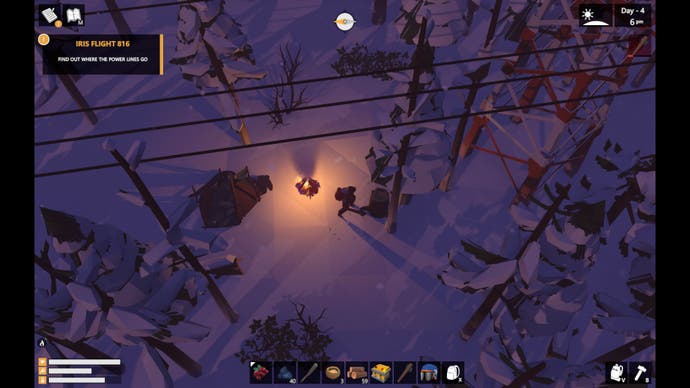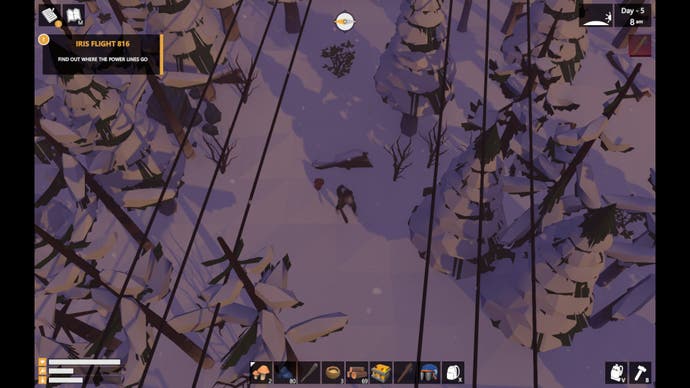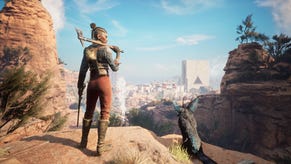The Wild Eight is survivalism served extra-cold
A song of ice and fire.
Eight Point's debut effort isn't a particularly unusual survival game, at least on the strength of a few hours play, but it does handle some well-worn ideas with thrilling starkness. In particular, I really like what it does with fire. If wood-chopping, mining, hunting and crafting are the verbs that carry you through this Alaskan wilderness, campfires are the punctuation points - fleeting reprieves from the chill of nightfall, where you can cook otherwise poisonous food, patch your wounds, hone your character's fledgling ranger skills and maybe knock together a pair of clogs without worrying (quite so much) about dying of hypothermia.
Viewed in top-down, it all makes for an arresting tableau. Firelight etches deep, twitching shadows into the surrounding, procedurally generated woodland, warming the flat planes of the game's stylised geometry. The listless piano score fades as darkness sets in, leaving you all alone with the crackle of twigs, the shifting of snow-covered branches, the scuffles and howls of passing animals.

Eight Point's nine members proudly declare themselves to be residents of Yakutia, a wintry expanse the size of India that houses a population smaller than that of Rhode Island, and while I doubt they developed this game while crouched in a makeshift tent, it certainly feels like the work of people who are intimately familiar with the experience of being very, very cold. There's a sense of actual, tangible peril to it that survival games often fail to convey, preferring to bury you in vaguely anxiety-inducing drudgery.
Not that The Wild Eight is without its share of drudgery. The game casts you as one of eight survivors of a mysterious plane crash, and whether you play as tough oil rigger William or frail medical student Mandy, you'll be spending a lot of your playthrough tending to rapidly depleting hunger and temperature gauges while scouring the world for wood, rock and things to kill and/or eat. Die and, assuming there isn't a co-op partner with a defibrillator around to revive you, you'll respawn back at the crash site as a level 0 character without all your precious equipment. You can then, if you choose, visit the site of your death in order to cannibalise your remains. The game's multiplayer, which I've only scratched the surface of, makes cannibalism more of a theme - when you're caught in the grip of a random blizzard with no wild mushrooms to munch on, the thought of dining out on an ally has a worrying appeal.
Central to all this are your tent and workshop, which can be packed up, carried around and deployed at no additional resource cost once assembled. Workshops are for bodging together needful things such as healing ointments, pickaxes and rabbit traps. Tents are for training your character up in the finer arts of survival, such as how to sprint when you're being chased by a hungry wolf, or how to get 5 wood instead of 3 when you punch a tree. You can also, very usefully, stop your bars depleting by seeking refuge within for two minutes (around six or seven in-game hours) given sufficient firewood.

The game's HUD and menus are simple and elegant, with big, clickable icons, though the act of dragging and dropping items (for example, food onto your character) is a little fiddly. The procedurally generated terrain is somewhat blemished by too-obvious repeated elements, such as wolfpacks that always spawn near abandoned buildings, but it succeeds in holding the attention, even as the mechanics grow familiar.
Partly, that's because you can make your mark on it - resources don't magically respawn when out of view, so exploration becomes a matter of working out which regions you've yet to trawl, and whether there's an old campsite you can avail yourself of along the way. And the deeper you delve, the more you'll become aware that something is rotten at the world's core. There's that old field laboratory I found, for one thing, its caved-in buildings strewn with cryptic journal entries, and there are those weird metallic noises you may hear at night. All of which is reason-enough to stick with the game as it begins its journey through Early Access, but for me the key draw is still the sight of those fragile blazes flickering amongst the trunks, keeping winter marginally at bay.






.png?width=291&height=164&fit=crop&quality=80&format=jpg&auto=webp)


